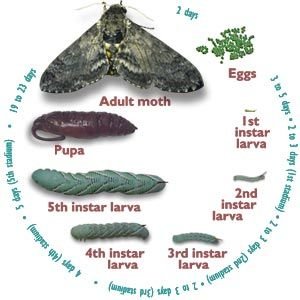
You might be wondering why hornworms matter. They might seem like pests when they’re devouring your tomatoes, but these caterpillars are essential to the ecosystem. They provide food for birds, maintain plant health, and, of course, transform into moths. So, let’s take a closer look at the stages of their lifecycle and discover the important role they play.
The Lifecycle of Moths: An Overview
To understand the role of hornworms, we first need to grasp the overall lifecycle of moths. Moths, like butterflies, undergo a process called metamorphosis, which has four main stages: egg, larva (hornworm), pupa, and adult moth.
1. **Egg Stage**: Moths begin their journey as eggs, often laid on the leaves of plants. These eggs are tiny, usually not bigger than a pinhead, and can blend into their surroundings. Depending on the species, the eggs may hatch within a few days to a couple of weeks.
2. **Larva Stage (Hornworm)**: After hatching, the baby hornworms emerge, ready to eat. This stage is all about growth. Hornworms have an insatiable appetite, munching on leaves and stems, which helps them store energy for the next phase. They can grow very quickly, often doubling in size just within a few days.
3. **Pupa Stage**: Once the hornworm is fully grown, it’s time for a big change. The caterpillar will find a safe spot, usually in the soil or under a leaf, and form a protective casing called a chrysalis or pupa. Inside, it undergoes a remarkable transformation, breaking down its body and reforming into a moth.
4. **Adult Moth**: Finally, the adult moth emerges from the chrysalis. It expands its wings, allowing them to dry and harden before taking off into the world. Adult moths will then mate and lay more eggs, continuing the cycle.
You see? Each stage plays a crucial role in this lifecycle, with hornworms acting as the vital feeding stage.
The Role of Hornworms in the Ecosystem
Hornworms may seem like mere garden nuisances, but they actually contribute significantly to their ecosystems. Here’s how:
– **Food Source for Predators**: Hornworms serve as an essential food source for various predators, including birds and insects. As they munch on plants, they unwittingly help support larger creatures in the food chain.
– **Pollination**: When hornworms eventually turn into moths, many species become essential pollinators. While sipping nectar, adult moths help plants reproduce, ensuring a healthy environment.
– **Nutrient Cycling**: When hornworms eat plants, they help in nutrient cycling. When they eventually die or are eaten, they return nutrients to the soil, further enriching the ecosystem.
This symbiotic relationship underscores the interconnectedness of life in our gardens and natural habitats.
Now, let’s talk about how hornworms affect gardens. If you’ve ever grown tomatoes or peppers, you might have encountered these pests. While they can be damaging, understanding their lifecycle can help you manage them effectively.
– **Leaf Damage**: Hornworms can strip plants of their leaves quickly. A single hornworm can eat an entire tomato plant in just a few days! This damage can weaken the plant, making it susceptible to diseases.
– **Natural Control**: On the flip side, hornworms can help maintain a balance in the ecosystem. Encouraging natural predators like birds or beneficial insects can keep the hornworm population in check, reducing the need for chemical interventions.
– **Harvest Timing**: If you know when hornworms typically hatch, you can plan your garden accordingly. Keeping an eye on your plants and using barriers can also help protect your garden from these hungry caterpillars.
Recognizing hornworms is pretty easy if you know what to look for. Here are some key features:
– **Color**: Most hornworms are bright green, which helps them blend into the foliage. However, some may also have a brownish tint.
– **Size**: They can grow quite large, up to 4 inches long, making them hard to miss if you’re inspecting your plants.
– **Caterpillar Markings**: They often have white or yellow stripes along their sides and a horn-like protrusion at one end, giving them their name.
– **Frass**: Look for droppings—commonly called frass—near your plants. This can be an indicator of a hornworm infestation.
Spotting these signs early can save your garden from significant damage.
If you find hornworms taking over your plants, don’t panic! There are several ways to manage them effectively without resorting to harmful chemicals.
1. **Handpicking**: One of the simplest methods is to handpick them off your plants. Check the undersides of leaves where they like to hide, and drop them into a bucket of soapy water to dispose of them.
2. **Natural Predators**: As mentioned earlier, attracting natural predators can help. Birds, wasps, and beneficial insects will help keep hornworm populations under control.
3. **Insecticidal Soap**: If you have a more significant infestation, consider using insecticidal soap. It’s a less toxic option and can help manage hornworm populations effectively.
4. **Organic Pesticides**: Products containing Bacillus thuringiensis (Bt) are effective against hornworms but safe for beneficial insects.
Remember, you can keep hornworms in check without harming the environment or your garden.
The lifecycle of hornworms is a vivid reminder of nature’s intricate connections. From their humble beginnings as eggs to their transformation into stunning moths, hornworms play a pivotal role in gardens and ecosystems. While they might be a nuisance when they’re munching on your plants, understanding their lifecycle and impact helps you see them in a new light. By managing their populations responsibly, you can embrace the benefits they bring while protecting your garden. So, the next time you spot a hornworm, take a moment to appreciate its role in the beautiful dance of life!
